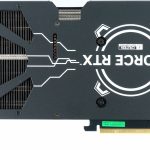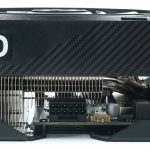I’ve already tested a few RTX 4070 Ti Super cards, but today it’s the KFA2 GeForce RTX 4070 Ti Super EX Gamer 16 GB, which, in addition to ARGB, also wants to score points with its price of currently just under 900 euros. This is currently only 10 euros above the RRP, but it is an OC card and equipped with a disco feeling. The so-called MSRP cards, on the other hand, all come without OC options and lighting. But is the small surcharge worth it for the well-being of an RGB and OC-addicted gamer?
It is therefore not a real MSRP card, but offers significantly more coolers and optical features than the two MSRP cards recently tested. However, the final opponent of this GeForce RTX 4070 Ti Super is once again AMD’s Radeon RX 7900XT, which is currently available at a slightly lower price. And this is precisely what makes the Ti Super launch so difficult from a customer perspective, even today. Do you dare to make the monetary leap to a GeForce RTX 4080 Super or is a GeForce RTX 4070 Super perhaps enough? The GeForce RTX 4070 Ti Super is actually for anyone who doesn’t want to splash out, but also doesn’t want to splash out too much. Well, just under 900 euros is still a lot of money, but not 1000 either. I wouldn’t want to call it a sensible card, but it’s a useful compromise.
I’m testing the KFA2 card in its delivery state today, whereby it is representative of the entire 285-watt class of cards, as the performance is identical. OC is therefore not the main topic today, although the power limit can be raised to up to 320 watts. You wouldn’t need more anyway, because at some point the voltage would limit it anyway. I think this large margin for only 10 euros above the RRP is a fair offer. If you want to overclock at all.
Important foreword
Of course, as usual, there are many benchmarks, the comprehensive teardown, a very elaborate board, cooler and material analysis with some reverse engineering, as well as the analysis of the power consumption and load peaks including a suitable power supply recommendation. As I know that many colleagues will also repeat all the technical details and theory, which have already been presented in various snippets, I’ll save myself the trouble today and just briefly refer to the data already known. After all, you want to see real figures today and not PR fireworks. The specs will of course be coming soon, the chip on my test object from calendar week 47 of 2023.
The AD 103-275 and the new Ada architecture
The GeForce RTX 4070 Ti SUPER is primarily delivered with the AD103-275 SKU, but the rumored AD102-175 GPU (different board, PG141 SKU 323) is also possible. However, both variants are equipped with a total of 8,448 cores and 48 MB L2 cache. The graphics card will have 16 GB GDDR6X memory, which corresponds to a VRAM upgrade of 4 GB compared to the RTX 4070 Ti Non-SUPER and thus support a 256-bit bus interface. The graphics card has a TBP of 285 watts, which in turn corresponds to the value of the non-SUPER variant.
On paper, the card offers an average performance increase of 10% over the non-SUPER variant and is expected to compete well with the Radeon RX 7900 XT and yes, AMD is not only taking up the gauntlet but has drastically reduced the price of the RX 7900XT to do so. However, as with the non-SUPER cards, there is no NVIDIA’s own Founders Edition (FE), only AIC cards, one of whose shining representatives I am testing today.
The 66 (instead of 60) 3rd generation RT cores offer up to twice the ray tracing performance, while Shader Execution Reordering (SER) also improves ray tracing operations by a factor of two. In addition, there are a total of 264 texture units (TU) and 96 ROPs. The L2 cache is 48 MB in size and, like the GeForce RTX 4070 Non-Super, the card uses the familiar 16 GB GDDR6X with 10500 MHz clock rate, but this time on a suitable 256-bit interface, which corresponds to a data rate of 21 Gbps and a bandwidth of 627 GB/s. The card also offers only one NVDEC (decoder) instead of four, but at least two NVENC (encoders). The AV1 encoder is said to work up to 40% more efficiently than H.264.
The card still relies on a PCIe Gen. 4 interface and only for the external power connection with the 12VHPWR connector (12 4 pin) on an element of the PCIe Gen. 5 specification. The TDP is 285 watts and can be increased even further depending on the board partner.
| RTX 4080 Super | RTX 4080 | RTX 4070 Ti Super | RTX 4070 Ti | RTX 4070 Super | RTX 4070 | |
|---|---|---|---|---|---|---|
| GPU | AD103 | AD104 | ||||
| Transistors | 45.9 billion | 35.8 billion | ||||
| The size |
379 mm² | 295 mm² | ||||
| SM | 80 | 76 | 66 | 60 | 56 | 46 |
| FP32-ALUs | 10.240 | 9.728 | 8.448 | 7.680 | 7.168 | 5.888 |
| RT Cores | 80, 3rd Gen | 76, 3rd Gen | 66, 3rd Gen | 60, 3rd Gen | 56, 3rd Gen | 46, 3rd Gen |
| Tensor Cores | 320, 4th Gen | 304, 4th Gen | 264, 4th Gen | 240, 4th Gen | 224, 4th Gen | 184, 4th Gen |
| Base Clock | tbc | 2.210 MHz | 2340 MHz | 2.310 MHz | 1.980 MHz | 1.920 MHz |
| Boost Clock | tbc | 2.510 MHz | 2610 MHz | 2.610 MHz | 2.475 MHz | 2.475 MHz |
| FP32-Perf | 52 TFLOPS | 48.8 TFLOPS | 44 TFLOPS | 40.1 TFLOPS | 35 TFLOPS | 29.1 TFLOPS |
| L2 cache | 64 MB | 48 MB | 48 MB | 32 MB | ||
| Memory | 16 GB GDDR6X | 12 GB GDDR6X | ||||
| Throughput | 23 Gbps | 22.4 Gbps | 21 Gbps | |||
| Interface | 256 bit | 192 bits | ||||
| Bandwidth | 736 GB/s | 717 GB/s | 672 GB/s | 504 GB/s | ||
| Video engine | 2 × NVENC (8th Gen) 1 × NVDEC (5th Gen) |
1 × NVENC (8th Gen) 1 × NVDEC (5th Gen) |
||||
| TDP | 320 watts | 285 watts | 220 watts | 200 watts | ||
| RRP (DE) | 1.109 Euro | 1.329 Euro | 889 Euro | 899 Euro | 659 Euro | 659 Euro |
GPU-Z gives us the exact details for the KFA2 card, including the small clock plus already allocated ex works. But there is much more to it…
The KFA2 GeForce RTX 4070 Ti Super EX Gamer 16 GB in detail
The card weighs a whopping 1453 grams and is a real, colorfully illuminated brick in terms of weight. But the flexible graphics card stand is included to lighten the load. However, the length of 32.5 cm is more than ample and the height of 12.5 cm is also above the normal height of 10 cm. In addition, the height means that you have to use the great 12VHPWR adapter, but with 2x 6 2-pin at the PCIe output, it is also just about suitable for OC. The installation depth is a whopping 5.5 cm plus the 5 mm for the backplate attachment on the rear. This makes it a 3-slot card.
The black look with the translucent fans is certainly not to everyone’s taste, but is well known from KFA2, along with the design language of the fan, cover and slot bracket.
KFA2 also uses a single BIOS and if you want to overclock a little, you have to use a suitable tool for the clock, even if the power limit is fixed. The in-house software offers “1-Click-OC”, although much more can be done manually. The feel is somewhat due to the material, but does not look cheap or even too obtrusive. Incidentally, there is also an exciting material analysis waiting for you, but all in good time.
You can not only plug power into the card, but also video connections. There are four of them, to be precise: three DisplayPort 1.4a and one HDMI 2.1a. This is a shame, especially for DisplayPort, when it comes to the new specifications. A missed opportunity, unfortunately. And with HDMI, you have to play around with the compression from 4K onwards if you want to go above 120 Hz.
That’s this first page done and we’re slowly getting ready for the test.
KFA2 GeForce RTX 4070 Ti SUPER EX Gamer (1-Click OC), 16GB GDDR6X, HDMI, 3x DP (47UZM6MD9BUK)
 | siehe Shop | 869,99 €*Stand: 27.07.24 03:26 |
 | Onlineshop: sofort ab Lager, Lieferung 2-3 WerktageBerlin, Hannover/Laatzen: lagernd (keine Online-Reservierung möglich)Dortmund, Düsseldorf, Hamburg, München, Stuttgart: nicht lagerndStand: 27.07.24 03:43 | 869,99 €*Stand: 27.07.24 03:44 |
 | lagernd | 879,00 €*Stand: 27.07.24 02:00 |
- 1 - Introduction, technical data and technology
- 2 - Test System und Messequipment
- 3 - Teardown: PCB, components and cooler
- 4 - Teardown: material analysis
- 5 - Gaming Performance FHD (1920 x 1080)
- 6 - Gaming-Performance WQHD (2560 x 1440)
- 7 - Gaming Performance Ultra-HD (3840 x 2160)
- 8 - Power cioonsumption and balancing
- 9 - Transients and PSU recommendation
- 10 - Temperatures, clock rate and infrared
- 11 - Fan speed, noise and audio sample
- 12 - Summary and conclusion























































80 Antworten
Kommentar
Lade neue Kommentare
Mitglied
Mitglied
Mitglied
Veteran
Mitglied
Mitglied
Mitglied
Moderator
Urgestein
Urgestein
Urgestein
Urgestein
Urgestein
Urgestein
Urgestein
Mitglied
Veteran
Urgestein
Alle Kommentare lesen unter igor´sLAB Community →